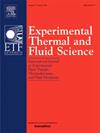An experimental study on gravity effect on frosting characteristics on surfaces of cold surface under natural convection
IF 2.8
2区 工程技术
Q2 ENGINEERING, MECHANICAL
Experimental Thermal and Fluid Science
Pub Date : 2024-12-31
DOI:10.1016/j.expthermflusci.2024.111405
引用次数: 0
Abstract
Frosting phenomenon is widely seen in nature and also observed in space station. To deeply understand the gravity effect on frosting characteristics, and thus accurately predict and control the frosting process in space station, series of frosting experiments were designed and conducted on cold surface with three different placement angles at surface temperatures of −25 °C and −15 °C under natural convection. The results show that gravity primarily affects the frosting characteristics by changing the flow field of water vapor and the heat transfer capability near the frost layer surface. As cold surface placement moves from horizontal to vertical to inverted, the peak value of average frost layer thickness during the early stage increases to 206.43 × 10−6 m and 297.14 × 10−6 m, and the peak frosting rate is reduced to 4.98 × 10−6 m/s and 3.47 × 10−6 m/s throughout the whole frosting process, respectively. With the changing of cold surface placement, the time when the first reverse melting occurs on the frost layer surface was extended by 121.53 % and 57.37 %, the frequency of reverse melting was reduced by 30 % and 40 %, and the maximum value of reverse melting was reduced by 79.53 % and 91.09 %, respectively. This study could serve as a reference for frosting models, or development of anti-frosting or defrosting technologies in space station.
自然对流条件下重力对冷表面结霜特性影响的实验研究
结霜现象在自然界广泛存在,在空间站也能观察到。为深入了解重力对空间站结霜特性的影响,准确预测和控制空间站结霜过程,在自然对流条件下,在- 25°C和- 15°C的表面温度下,设计并进行了三种不同放置角度的冷面结霜实验。结果表明,重力对结霜特性的影响主要是通过改变霜层表面附近的水汽流场和换热能力来实现的。随着冷面布置由水平向垂直向倒转,前期平均霜层厚度峰值分别增大至206.43 × 10−6 m和297.14 × 10−6 m,整个结霜过程中霜层速率峰值分别减小至4.98 × 10−6 m/s和3.47 × 10−6 m/s。随着冷面放置位置的变化,霜层表面发生第一次反融的时间分别延长了121.53%和57.37%,反融频率分别减少了30%和40%,反融最大值分别减少了79.53%和91.09%。本研究可为空间站结霜模型的建立及防霜除霜技术的发展提供参考。
本文章由计算机程序翻译,如有差异,请以英文原文为准。
求助全文
约1分钟内获得全文
求助全文
来源期刊

Experimental Thermal and Fluid Science
工程技术-工程:机械
CiteScore
6.70
自引率
3.10%
发文量
159
审稿时长
34 days
期刊介绍:
Experimental Thermal and Fluid Science provides a forum for research emphasizing experimental work that enhances fundamental understanding of heat transfer, thermodynamics, and fluid mechanics. In addition to the principal areas of research, the journal covers research results in related fields, including combined heat and mass transfer, flows with phase transition, micro- and nano-scale systems, multiphase flow, combustion, radiative transfer, porous media, cryogenics, turbulence, and novel experimental techniques.
 求助内容:
求助内容: 应助结果提醒方式:
应助结果提醒方式:


